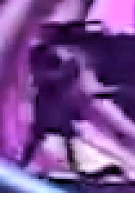Please note that some programmes in this period have their own page!
Eurovision Song Contest
Alec Bray
Did you spot the Steadicam?
Very difficult! This was during Norway’s entry – Jowst – and it is only really noticeable in the moving picture. The Steadicam is slinking off stage.
(Click on the pictures below to see a larger or clearer version of the picture:
Click the “X” button (top right) to close the newly opened picture.)
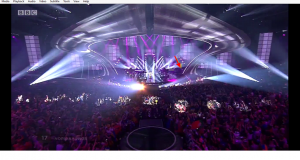
A couple of “frames” later it is clearer:
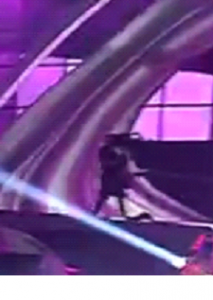
(see also http://tech-ops.co.uk/next/great-developing-shots-in-cinema/)
which references the Steadicam from the Eurovision Song Contest 2009 …
Nick Ware
“The most ridiculous Steadicam shot”. Karsten Jacobsen starts off at top speed on a Segway and steps off onto the stage. Spectacularly brave on a live show to millions of viewers! Or maybe, just spectacularly skilful…
Peter Neill
And here’s the automated vision mixer in action.
They don’t even have to press F12
(Click on the pictures below to see a larger or clearer version of the picture:
Click the “X” button (top right) to close the newly opened picture.)
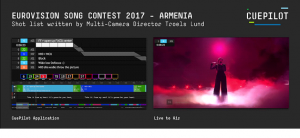

A short snippet to give you the feel of it is here: CuePilot: Armenia Entry (no sound)
(fair use)
Bernie Newnham
Seems like a sledgehammer to crack a nut. All you need is a Hilary.
“Doctor Who”
Bernie Newnham
For those who like to talk (a lot) about sound, “Doctor Who” TX 6 May 2017 is in binaural sound on the iPlayer.
See item http://www.bbc.co.uk/rd/blog/2017/05/doctor-who-in-binaural-sound
“Click” also has an item on it.
Has anyone tried listening to the Binaural “Doctor Who”?
I haven’t put my cans on, but I’ve just been running it on my 4 speaker system. Everything sounds normal, just two channel stereo.
John Howell
Well it was certainly good in plain old stereo, the plot lent itself to a bit of fun with the pan pots!
It was rewarding to see the artists look in the direction that you’ve just heard a sound.
You need the cans! Binaural doesn’t work on loudspeakers because of the cross-talk between the channels.
Dave Mundy
The old IBS had a meeting about binaural sound. They played a tape of a recording done on a traffic island on the Strand in London’s West End. We listened on headphones and the effect was amazing, trying to dodge taxis etc.! Well worth a listen! They used a dummy head with two ECM 50s where the ears would be.
Dave Plowman
And oddly, binaural on cans seems to work for some better than others. Some people report being able to tell if things are above or below them too.
Mike Giles
To some extent, it probably depends on how closely your ears match the labyrinth on the dummy head.
John Howell
The “Doctor Who” episode was very impressive, the headphones gave isolation from living room clocks etc and being decent cans (AKG) the low to mid frequencies were cleaner without any resonances due to the room.
As I suggested earlier (the stereo version), the cast looked at where a sound came from, that underlined the position of the audio, and it did work: I was convinced that some sounds came from behind, I even looked round at one point! The ‘above or below’ comment can be clouded by expectation, you would not (often!) hear an aircraft passing below you so it must be above.
One thing I found strange was nobody took the slightest notice of the colossal thunderstorm of Frankenstein proportions going on outside. I suppose they were all locked into squeaky floorboards so to speak.
One other criticism I had of the sound was when conversations continued as we panned away the acoustic was missing, they were heard, albeit quietly as if they were still there, not four paces down a wooden corridor.
However it was a very enjoyable episode
Sgt Pepper’s Musical Revolution with Howard Goodall
Dave Plowman
There must be a few Beatles fans amongst us, so for those who may not have been paying attention, a re-mix of Sergeant Pepper is now on sale.
The story goes that the original was mixed down in mono with the ‘lads’ present, while the stereo sort of done on auto pilot. So this re-mix, just from the original multi-tracks, is an attempt to reproduce that original mono balance but in stereo. The package includes a second CD with out takes.
It is certainly interesting to spot the differences if you have a good memory, or an original to compare to.
John Howell (Hibou)
There was a very interesting programme on BBC 2 (3rd June 2017): “Sgt Pepper’s Musical Revolution” with Howard Goodall.. A fair bit about multitracking and voice treatment, the background to the lyrics, and the opening notes of “Strawberry Fields” played on a Mellotron!
Graeme Wall
Excellent programme. He did one a couple of years ago on the history of the symphony. A demo bit of baroque music sounded like yer actual Bach till the choir came in, it was Status Quo’s “Rocking All Over The World”!
Mike Giles
Quite a good voice too, Howard Goodall.
Alec Bray
When “Strawberry Fields” was first released, I was on Pres B secondment (as far as I recall). We copied the track onto tape, then took it to a BTR2 down in, I think, Central Apparatus Room (long time ago, sorry if it’s wrong). We played the track backwards and forwards and at all sorts of speeds, and those with sound in their system reported themselves mystified as to how it was all done: the best idea at that time was “pre-echo”.
The programme “Sgt Pepper’s Musical Revolution” was rather spoilt by showing repeated shots of 2” tape, when the archive material clearly showed 1/4 inch tape – four tracks on each pass.
John Howell (Hibou)
I don’t know what was meant by the term ‘pre-echo’ in this context, I always associated it with ‘print-through’ on magnetic tape, the reproduction of a sound from the next revolution of a feed spool being imprinted on the current one, usually due to too tight a wind or long term storage without rewinding.
Of course you can do quite a lot of Mellotron stuff, including the aforesaid notes on an iPhone app. called ‘Manetron’. It even has the option of the noise of the capstan motor and that of the tapes rewinding when you take your fingers off the keys.
I always understood they used a 4-track tape machine hence the slate words heard at one point ‘mix down from 4-track’.
Nick Ware
It was a four track 1″ Studer J37.
Dave Plowman
That was what I thought. 4 tracks on 1/4 would have to wait a while.
Didn’t they actually use two 4 tracks for some of the stuff? Not locked as you could do with time code, of course.
Alec Bray
Thank you all for the clarifications!
By the time that “Strawberry Fields” was released, I was very firmly on the Vision side of things: so all I can do is to try to convey what we did at the time.
Someone got hold of a copy of “Strawberry Fields”. The next bit I remember is a group of us – perhaps 5 or so ? – gathered around a BTR2 playing a tape onto which the track had been recorded. We had had to go on a search for a (nearby) BTR2, and the one we found was surrounded by other equipment and bits and bobs, which makes me think we went to CAR.
We were in Pres B at the time – so that would be query 3 camera persons and a couple of sound persons? Help – I can’t remember!
Anyway, we subjected the tape to various speeds and in both directions. The sound people confessed themselves mystified – there were certainly comments like “I don’t know how they did that” all the way through – I think that somehow someone knew that the original equipment had been four track, and the guys were trying to figure out how they could reproduce that sound using the standard Sound Gallery equipment at the time.
Now, being a vision person, I may well be digging myself a hole here! I think that the general consensus from the sound people was that the sound sounded like an echo response played backwards – would that be the attack and decay? But this was at the start of the notes. I guess that with experience of print-through etc it sounded like something of the same.
We certainly did not think of a Mellotron! At that time, the BBC (Management? Sound?) thought the Mellotron could be used for sound effects generation, and loaded it accordingly – thanks to Pat Heigham for that (see http://tech-ops.co.uk/next/2016/03/tv-technology-over-the-years-bbc-practice/) and that certainly “CHIMES” with my recollection – I think that I saw it in one studio gallery once, but that may be a false recollection, of course.
In the programme “Sgt Pepper’s Musical Revolution” 1″ tape machines are shown (as well as others) , but at times 1/4 tape is shown: these pictures show the tape loops used in “For the Benefit of Mr. Kite”. I’ve left the time references in these screen captures.
(Click on the sbelow to see a larger or clearer version of the picture:
Click the “X” button (top right) to close the newly opened picture.)
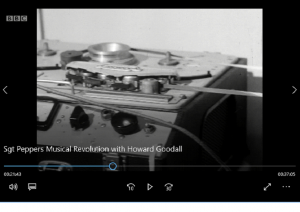
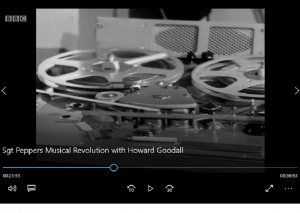
All interesting material!
John Howell (Hibou)
Thanks for your deliberations Alec. I seem to remember that if you pressed a Mellotron key in a certain way you could ‘fade in’ the note such that the sharp leading edge would not be heard. You were in fact ‘landing’ the tape gradually onto the replay head. This also had the effect of muffling the start as the higher frequencies were last to arrive so to speak. I’m sure you’re right though, the main ‘trick’ was to play it backwards.
All the above was discovered using our sound effects Mellotron which lived for a while in TC4 and ended up in the Sypher Studio.
I believe one of the 4 track tape machines appeared in a small studio in a basement off the Fulham Road run by ex SA1 John Milner.
I don’t think BTR2s made it to TVC it was most likely a TR90 like the one seen in the second screen grab.
Pat Heigham
BTR2s were in Riverside’s Music Studio for a while, until re-equipped with the lovely Studers.
I remember using BH for some recording and editing sessions, where the BTR2s had an add on extra motorised reel mount for spooling off the unwanted takes to a separate reel. Jolly useful, that!
In my time, TVC and LG had TR90s and Leevers Rich. I hated the latter, and for “Dr. Who”, always tried to insist on TR90s as the fast start was ace for spot cueing FX.
I used John’s studio to record narration voice-overs for ‘The Naked Civil Servant’ (with John Hurt).
I chiefly remember John Milner after a “Top of the Pops”, in LG (G), when the PA came in with an acetate disc of a number required for the next week’s show. She needed to time it. It was Tom Jones’ “Delilah”. After we played it, John, who was stashed in the corner of the gallery, mournfully uttered: “That’s going to be a huge, and horrible hit!”
Tony Crake
Johnnie Milner’s studio was called Studio G as I recall.
John Howell (Hibou)
Thanks for pointing out the BTR2s in Riverside.
As you can see from the attached pic I encountered them at Wood Norton.
(Click on the picture below to see a larger or clearer version of this picture:
Click the “X” button (top right) to close the newly opened picture.)
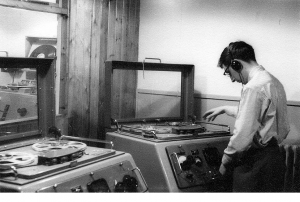
I recall Percy Guy setting faults for the TAs, one of which was to swap over the top caps of two of the valves in the playback amplifier so it became a shrieking oscillator. Or he would stand in front of the monitor speaker and quiz the poor lad about a lack of high frequencies.
We had a batch of new Leevers-Rich, possibly after Pat Heigham had left, and they were brilliant for fast starts — for a week or two, then they became as sluggish as the older ones. We kept bleating at poor old Sound Maintenance (Peter Whitby in those days) “Why can’t you get these machines back to their original performance?”
The reply: “They’re within spec”.
The slowest start I ever transmitted was when I was in Pres. and there appeared to be no-one around to start the next trade test tape so I volunteered. No-one told me that they didn’t leave the capstan motor running continuously!
Dave Mundy
Birmingham Studio Centre, Broad Street, had several BTR2s with a central console and a pluggable vari-speed ‘BAY'(!) full of purple-glowing glass bottles!
Dave Plowman
Anyone with radio connections remember the BTR2 GT? It was a BBC update using the same basic deck, but more modern solid state electronics. It probably had an official number – I don’t know!
Dave Wagner
We had had the BTR2 GT in Cardiff (possibly called the BTR4 but I can’t remember that long ago) and they were supposed to be stereo capable but they were awful. The electronics were ok but the decks were worse the originals for usability. I’ve used the originals with the third take up motor for editing and very useful they were for dithering producers. It did mean you couldn’t trample all over the out-takes though!
Mike Giles
I must leap to the defence of the BTR2 – which generation I couldn’t say – but we had three edit suites in Bristol equipped with them, complete with outriggers, and ours certainly produced very convincing stereo – certainly equal to anything else we had in Bristol. Never mind dithering producers, producer present or not, I found that you could edit faster on the four reel set-up than any other machine that I’ve used, including the general radio favourite TR90. Not only that, but the enormous amplifier cupboard under the deck was the ideal place for keeping your sandwiches warm! What I fancy I do recall is that the machines which were “modernised” by having their valve amps replaced by transistor versions were not popular – no good for the sandwiches, for one thing!
The outriggers were also great fun when reclaiming spools, because you could wind the redundant tape around the spool-less spindle, then give full welly in forward fast wind and after a few seconds, a spiral of tape would rise from the outrigger, some eighteen inches or even a couple of feet above the deck.
Seriously though, one big advantage when editing was that by virtue of the outrigger switching, you could turn off the take-up spool, rather than having to hold it still by hand or jam a bit of folded card under the reel to stop it rotating. And such a pretty colour!
Pat Heigham
Reclaiming spools…..
Reminded me of a time on a TVC play – I was still assembling FX on 1/4″, when the director asked to rehearse the closing captions off telejector, and could I give them the end music.
The music was on a separate spool, but I didn’t have a spare take-up one, so quickly ran the music tape onto the floor and used its now empty spool for take-up. Cue music – cheerfully playing, until I noticed a wonderful knot of brown ribbon rising from the floor about to be mashed in the head block!
Panicked, hitting the stop button.
Puzzled bleat over talk-back: “The music’s stopped, Pat!”
Some more about BTR2s: this is from
http://tech-ops.co.uk/next/2016/03/tv-technology-over-the-years-bbc-practice/
“… The Music Studio at Riverside (formerly the music stage when they were film production studios) was equipped with firstly, EMI BTR2 tape machines which were standard kit in radio studios. Nice but very bulky. Later, the splendid Studer Swiss made decks were installed. These had a neat gadget in the form of a small pair of scissors which, on demand would rise from the deck surface and cut the tape. Sadly they offered a 60° cut which did not match the EMI Blocks in usual use. (People would come in and ask what does that button do? and press it, resulting in possible destruction of a master tape!)…”
Philip Tyler
My favourite tape story involves Ian Tomlin.
He was working on a play which was in the studios for several days. Ian had one sound fx to play in. So he put it on tape, edited it up and checked the level. And there it sat on the tape machine for a few days.
Just before the scene, with the sound fx in, the director asked if he could hear the fx and said ‘cue tape.’ So Ian played the tape and there was a deathly silence, Ian had forgotten to rewind it back to the front of the cue. But without batting an eyelid Ian goes into the production gallery and says to the director, “That tape you cued, had nothing on it.” Only Ian could get away with that, quite a character.
Dave Wagner
Don’t get me wrong! I have total respect for the original BTR2. With the outriggers, which we didn’t usually have, they were brilliant editing machines. I only came upon Mono ones in their original format. The re-vamped transistorised ones had a modified tape path to, in theory, stop tape weave for stereo but our machines just weren’t up to it really. The most user friendly machine for me was the Studer B62; the A80 was too big and cumbersome. I hated the TR90, it was so vicious with the tape I never trusted it.
Dave Mundy
.. but the TR90s could run backwards if you laced the tape round the pinch wheel – useful for back timing! I know someone who got a recognisable pulse-and-bar from one in fast forward! The Leevers-Rich’s great asset was the tape/direct switch where you could have grams feeding into the machine and switch instantly between those FX and those off tape (much quicker than faders!) and another set of FX on track 2 for example. Yes, I have used it like that!
John Howell (Hibou)
Agreed, and those switches were useful when the machine was used for delay before an echo plate. I refer to the occasions when you needed to rewind the tape, just flip to direct whilst spooling. At least you still had echo albeit no delay.
Nick Ware
The best editing machine of all time was the Philips Pro20, which had tactile pressure sensitive transport push buttons with feed and takeup pneumatic dashpot tension damping. That, and a clear tape path made it a dream to edit on and impossible to cause tape damage. I was lucky enough to own one up until a Nagra 4s with NAB reel adaptor took its place, but sadly that was a total mechanical nightmare with a chaotic will of its own! Following that, a Studer B67 and happiness again.
Now, it’s a Zoom F8 and SoundForge 11. If only I had had those then!
Nick Ware
I have just watched the Howard Goodall documentary, and I must say, it’s an eye (and mind) opener. Fabulous.
Something else closer to home that not everyone here might know: Maria Marshall’s husband Peter was a professional photographer and it was he who did much of the actual photography and paste-up for the Sgt Pepper cover artwork, though of course, Peter Blake took all the credit. I know this to be true because I well remember seeing a fair amount of raw material and rough assembly stuff at their house in Wembley. What I don’t know though, is whether ‘Marshall’ was his surname or Maria’s maiden name. Anyone know?
Tony Grant
When the Sgt. Pepper album was being digitally converted for its original CD issue (sometime in the early 1980s I think), I had the pleasure of following the process through. Now, I had filmed in operating theatres, and been hoovered, together with the equipment, to within an inch of my life. This was nothing compared to having to strip to underwear, and be sprayed, hoovered, and dressed in protective garments to enter the CD pressing room. No idea if any of this footage survives, or the interview we did with George Martin, but it did make for a couple of interesting days. I dropped hints about free samples for quality control, but deaf ears abound at this level of the industry!
Would be interested in the present re-issue, but only if I get the free sample,
Election Night Special 08 June 2017
Mike Jordan
I shan’t bother to sit up all night watching but anyone know where it is being done this time?
I seem to recall it was from Elstree Film Studios or whatever the BBC calls that space now?
Or maybe a broom cupboard in BH with a very bright green wall?
Rob Miles
It will be coming from Studio D at BBC Elstree.
Dave Plowman
I watched the Election coverage on BBC1 until about 2.30. Even Dimbleby commented on how bad
much of the sound from the declarations was.
I went to bed and switched on R4. I have a decent sound system in the bedroom – LS 3/5a speakers. And the declarations I heard on that were just fine.
If radio are allowed to have a mic in a decent position for the returning officer, why not TV? Many of them sounded like a mic on the camera – as audience reaction was OK.
I suppose it was the usual “sound is so easy we can leave it all to the cameraman” bit.
Also several of the interviews from locations were difficult to understand due to background noise. For heaven’s sake, if it’s noisy, use a decent hand mic rather than personal!
Graeme Wall
Journalists want everything on personals and it was their big night to play.
Dave Plowman
Then they should be told that hearing things is more important than being able to wave their arms around, or looking their best on camera.
Pat Heigham
I heard an interview with the presenter Adam Hart-Davies, who, when asked to describe his job, said: “I’m a testiculator. I wave my arms about and talk a lot of balls!”
Graeme Wall
Even when local sound was reasonable, it was at low level compared with the studio and they didn’t dip the studio mics during declarations. There was a distinct “Bloody Hell” from Dimbleby at one unexpected result, he presumably thought his mic was off.
Dave Plowman
Yes – it was quite scruffy. But that I can understand. Not having a mic in the right sort of place on a fixed stage or whatever is a different matter.
Casualty Saturday 29 July 2017
Dave Buckley
Listening to the 6am news this morning, there was an item about tonight’s
episode of Casualty, which has been shot as one continuous take…
see
http://www.bbc.co.uk/news/av/entertainment-arts-40760382/casualty-makes-british-tv-history
The director says that this is the first time this has been done –
effectively a 48 minute shot.
However, I remember an episode of The Bill which was one shot, albeit with
commercial breaks, and in the early 1970s, a director on a TV Training
course did his final production as a 25 minute one camera shot (I know as I
recorded it on VT at Woodstock Grove).
(Click on the pictures below to see a larger or clearer version of the picture:
Click the “X” button (top right) to close the newly opened picture.)
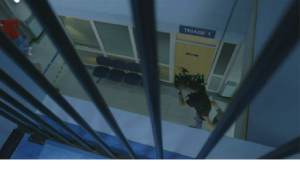
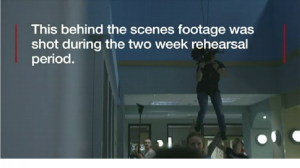
The director says that this is the first time this has been done – effectively a 48 minute shot.
However, I remember an episode of “The Bill” which was one shot, albeit with commercial breaks, and in the early 1970s, a director on a TV Training course did his final production as a 25 minute one camera shot (I know as I recorded it on VT at Woodstock Grove).
Dave Plowman
Yes – the famous children’s home shot on “The Bill”. But it only ran about 12 minutes. Very different then. Not actually a cam corder, but a separate M2 recorder carried by the assistant, and only a few feet of cable between.
Graeme Wall
The cameraperson on that episode was Alison Chapman.
Dave Plowman
I’ll be watching “Casualty” more out of interest. I’ve rather gone off soaps these days.
Nick Ware
Apparently the “Casualty” shot was done five or six times before they were happy with the take (just to show I’ve been paying attention).
[Ed: Trailer says eight.]
John Barlow
I was Jim (Atkinson)’s cable basher on a play called “The 7th Juror” (about 1974?) where Jim did the whole 55 minute shot in one take on a ped from the 7th Jurors POV.
There were two moments when he crabbed so perilously close to a hat stand that he almost knocked it over. I suggested that we move it and he said absolutely not – he knew he would be OK for the duration but if the actors messed up he needed the coats to briefly wipe the frame to black so as to have edit points rather than start from the beginning!
Graham Giles
On June 26th 1961 ‘Waiting for Godot’ a 90 min. Beckett play was broadcast on BBCtv. It was shot in Riverside on one take. The director was Donald McWhinnie and I believe the cameraman was Laurie Duley.
See – http://www.bfi.org.uk/films-tv-people/4ce2b7857b80c
Hugh Sheppard
May have been Laurie… but I’m sure Ken Major had a hand in this or another single-shot epic at around the same time.
Nick Ware
And there was “The Life of Galileo”, starring Leo McKern and directed by Charles Jarrett, 1964. I was still on crew 2 then, and I think I’m right in saying it was all on one Mole-mounted camera and went out live. Either TC1 or more likely in 1964, TC3. What year did TC1 open?
I seem to recall that it was also the first time we saw the Angenieux 10:1 zoom, which was partly what made that production possible.
Alec Bray
The original Angenieux 10:1 zooms were varifocal zooms (the focus changes as focal length (and magnification) changes, as compared to a parfocal (“true”) zoom lens, which remains in focus as the lens zooms): this meant that you had to prefocus on the object before you could zoom into it.
Dave Mundy
Wow, 10:1, that’s going some! Alan Gomery mentioned that they were using 95:1s at the Open!
see Golf
Some serious development work has gone on since 1964 methinks!
Bill Jenkin
And the old Varotal Studio zoom was only 3:1.
Chris Woolf
The extreme ratio zooms only become practical when you can have some form of image stabilisation.
It is amazing how far that has developed, both within lenses and in mounts on things like helicopters.
High speed electronics, micro-gyros etc have been at least as important as the glassware.
Pat Heigham
I worked on “The Little Prince” (1974) directed by Stanley Donen, in Tunisia, shot on the edge of the Sahara.
I was taken up in a helicopter to sort out radio sync playback from the chopper (That’s a story in itself!).
There was a 35mm Mitchell camera in a WesCam gyro mount, and I asked the operator – how stable was it?
We were up over the Chott el Djerid, a dry salt lake, with an infinity horizon. The operator drew a chinagraph line on the TV monitor at the horizon, and the pilot threw the craft around a bit. That horizon never shifted from the reference line! (I was mightily impressed).
(Click on the picture below to see a larger or clearer version of this picture:
Click the “X” button (top right) to close the newly opened picture.)

The aircraft and the pilot were supplied by the Tunisian Army, and as he resembled Omar Sharif, all the females on the unit tended to swoon when he came into the hotel dining room!. (Could be jokes about grabbing his joystick, here, but I will desist!)
Nick Ware
Not that I claim to be an expert, but high ratio zooms that stayed sharp throughout the range, and had a constant physical length, only became possible with the innovation of computer-aided design and machine control, and the ability to grind and polish non-spherical lens elements.
Alasdair Lawrance
Agreed that 95:1 is an astonishing ratio, but what about other factors, eg, f-stop, transmission, vignetting?
Chris Woolf
From the published spec; f1.7 at the wide end, f4 at the tight.
The optical performance of these lenses comes about through the use of asymmetrically shaped lenses, and was impossible with classic grinding techniques.
The Canon lens is an HDTV and so focus tracking, vignetting etc are extremely good. Some lenses (not sure about the Canon) even use servo tracking of the internal elements to maintain perfect focus tracking throughout the full range.
Technology really has come a very long way.
Alasdair Lawrance
That really is amazing. It seems not long ago that the biggest problem with zoom lenses was ingress/egress of air when zooming quickly.
Any indication of how much these lenses cost?
Chris Woolf
They rent for around £450 a day, or buy outright for £88k. The camera is always likely to come cheaper!
They really are incredibly clever now, with the internal servos linking zoom/focus so that you don’t even get an image size change as you refocus. Canon also originated the idea of using ultrasonic motors, which work by giving friction-coupled “nudges” to a rotor element. These are more precise and faster than conventional motors, and highly suited to auto-focus and image stabilisation. The later uses a floating lens in the middle of the zoom, which can be nudged up/down and left/right to keep a focused object steady in frame. The control is very sophisticated and can learn intended movements, and have one or other axis switched off to prevent it fighting fast pans etc.
Roger Bunce
“Casualty”: a 55 minute programme all done in one shot? Dunno what the fuss is about. I’ve often done shots that have lasted for 12 hours or more – operating a single camera – continuous development!
It wasn’t my fault that the Vision Mixer kept cutting away to other cameras, or that the VT Engineers only bothered to record the last couple of hours, or that my continuous development sometimes took me to the line-up chart, where it stayed while I popped down to the canteen. My single camera was shooting the whole time!
Pat Heigham
I recall a Russian film that was shot continuously (90min?) – probably on Steadicam (the guy must have been knackered afterwards!). It must have been electronic, as a 1000ft 35mm spool only runs for around 11 mins.
Graeme Wall
Doco about the Hermitage museum: they did two takes after abandoning the first take a few minutes in.
Nick Ware
It must be a lot easier making a doco about the Hermitage in one take, given that the pictures don’t speak or move!
Bernie Newnham
The Russian Ark was here – https://www.youtube.com/watch?v=RugncEOsTdE, with a rather smudgy “making of” here – https://www.youtube.com/watch?v=ORMTAKh4NHI .
[Ed: videos are no longer available … they have been taken down…sorry!]
The cameraman is at 03:30:
(Click on the picture below to see a larger or clearer version of this picture:
Click the “X” button (top right) to close the newly opened picture.)
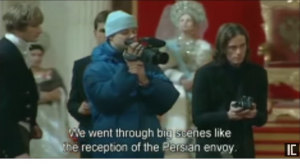
Tony Nuttall
The film on the History of Russia as told in a single take Drama with live actors,
2000 in fact , is called “THE RUSSIAN ARK” (2003), directed by Alexandre Sokurov.
The sequences were shot in the Hermitage. If you get the chance to view it , only £5-83 on Amazon, I would. I think you may be surprised by its artistry at all levels and personally I would not comment on it until you get the chance to view it.
Graham Maunder
It was actually a costume drama called ‘The Arc’ .
Apparently the Steadicam op and the director fell out big time and he never gets mentioned or praised in any article about it!
Nick Ware
Ah, so not a doco about the Hermitage as such then. A place I’ve spent quite a few fabulous hours, by the way, and would visit again in a flash, should the opportunity arise.
Do we know if the one-shot “Casualty” was the same cameraman all the way though, by the way? On The Bill there used to be a lot of nifty passing in-car cameras to a waiting cameraman outside the car for continuous scenes going into buildings, etc.
I suspect production talkback would have been more interesting to some of us than the programme sound!
Peter Leverick
I note with interest that on the credits there were 2 camera operators and a couple of focus pullers. Also the credits suggest a Movi rig was used rather than a Steadicam.
There was one shot which appeared to crane down over a balcony from one floor level to the ground level, this was done by a Kirby wire type of rig cleverly attached and then detached during the development. (see pictures: ed)
There was another shot where the camera passed (crabbed) over a bed, unless the Kirby wire was used again, that was probably where the rig was passed from one cameraman to another. My guess is that 2 cameramen shared the show.
Ed:
From the BBC news website:
http://www.bbc.co.uk/news/av/entertainment-arts-40760382/casualty-makes-british-tv-history
Director Jon Sen:
“… Even though we were using the lightest camera out there that was the quality we needed, after about twenty minutes the camera just became too heavy for that cameraperson, they started to shudder ever so slightly, at that point we do a very clever, I think, camera pass between two camerapeople so that you don’t actually realise that the camera has gone from one person to another…”
Having now listened to the director’s comments on the web link, I was right that there were 2 cameramen who ‘shared’ the shot. There was however a very interesting trick used to hide the camera when Duffy, Lily and the 2 trainee nurses took a group selfie, with the Casualty camera over their shoulders, which would normally have ‘photobombed’ the back of the selfie. I guess a pre-shot selfie was on the phone’s screen as it was presented. It was very well framed from the first moment it was presented.
(Click on the picture below to see a larger or clearer version of this picture:
Click the “X” button (top right) to close the newly opened picture.)
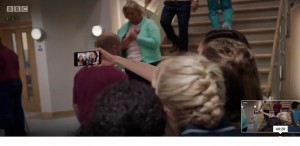
Peter Neill
Interesting, if overly detailed, piece about the sound coverage.
http://www.psneurope.com/casualty-30-years-single-shot-finale/
Spencer Chapman
I feel it is about time for the BBC to stop repeating that this production was the first of its type on British Television, and to give credence to all that have gone before.
It is a good example on how a well cut and assembled production can bring a level of excitement to a production – sadly missing last night
Thanks to all the cameramen who have gone before.
Geoff Fletcher
Another case of re-inventing the wheel!
I remember Peter Ware doing a very long continuous shot on a drama ped at Riverside – can’t remember what or when but it must have been in the mid nineteen-sixties. It lasted 26 minutes or so, and included him tracking back holding Jackie McGowan in MCU lit only by his camera headlamp whilst moving from one set to another!
I was his cable basher and remember wondering how he seemed to have so much time to do all the adjustments involved in working the ped etc. I have always considered Pete to be every bit as good at ped work as Jim Atkinson, but minus Jim’s, for me, somewhat overbearing arrogance. In fairness to Jim, however, I must admit I personally never got on with him, and therefore avoided working with Crew 5 as much as possible when I was on pools.
John Howell (Hibou)
“Point of Departure”, Jean Anouilh. 13th – 15th December 1964. R1.
A boom operator’s dream, one camera, 35˚ lens. Yes, the camera pulled back from the railway station and panned the artist into the hotel room, I seem to remember the lighting change was a problem on the take.
Dave Plowman
It was the first “Casualty” I’ve watched in a long time. Reminded me of why. Very very average acting/performance. Rather like “The Bill” which limped on long after its time was over.
Oh – the business with the oxygen mask in the ambulance looked just plain amateur.
Sorry to be so negative.
Dave Buckley
The write-up in the “Daily Mail” for the episode on Saturday makes interesting reading, particularly a reference to Hitchcock’s film “Rope”.
[Ed: “Rope” purports to be one shot.]
As to “Rope” being one shot – er, no it wasn’t – it was a shot per one reel of 35mm film (1000ft or ten minutes), so Hitchcock had to build in a stop at the end of each reel. It’s a long time since I last watched “Rope”, but it was obvious where the breaks came, even without watching out for the changeover dots.
Overall, the Mail’s critic didn’t much like the episode and has only given it two stars.
Dave Plowman
I like drama made for TV. The decent stuff. Doesn’t have to be gritty or all-action. Just a decent story, well told technically, and reasonable acting. So I’ve enjoyed everything from “Last Tango” to “Happy Valley”.
Sadly that episode of “Casualty” didn’t have me waiting for the next one.
Rock Goes to College
Peter Cook
I watched the repeat of “Rock Goes To College”, recorded in 1980 at Oxford Polytechnic (now Oxford Brookes) shown on BBC 4 in tribute.
Not bad for EMI 2001s and nice to be reminded that shots used to be held for long enough to mean something.
But I was wondering during the last number why in the back of shot, a camera was pointing sideways and downwards, until the credits ran and reminded me that he was obviously framing the roller caption (remember those?) The cameraman was unidentifiable and although I was there I do not have Geoff type records of who did what where.
A few weeks back I had a similar deja vu experience watching a John Denver concert shot at Wembley Pool (or Arena) in 1978. Having been Sup on that, I could visualise where the stage was (central like a boxing ring) before watching the show, but do not remember the crew. Who was there?
And on another subject: wasn’t it good to see the programming yesterday evening (24th October 2017) on BBC2 – with no music? I was able to put the remote down for a while! Mind you I had to pick it up again to view a recording of “Liar” and should have taken a sea sickness pill to counter all the wobbly vision.
Newsnight – Technical Issues
Dave Plowman
For those who were tucked up in bed Wednesday 17th May 2017 and didn’t see it:
The main part of “Newsnight” came from Northern Ireland, and the lighting console (I guess) decided to exercise its own control over things. Perhaps in response to everyone talking together. First the camera right key went down. Nothing much seemed to happen. Then I think they put the house lights on. Should have stayed like that – but no, attempts were made to get back to normal but sadly racks were rather left behind. Of course in these days it might well be one poor sod doing the lot. And did I feel sorry for him.
Then back in London, we either had an adventurist director, or the remote cameras went mad. Very odd back of the head shots and hard profiles. And some very strange development shots.
I would be interested to hear a proper analysis ….
Peter Cook
There seems to be a trend for people to talk without listening, and chairmen like the Dimbleby brothers seem to have forgotten their role and are all too ready to give their opinion instead of controlling the panel.
Kirsty seemed unable to have any control over the guests in Ulster last night. This demonstration in how not to do television followed closely on from the “10 O’clock News”, from which had just I switched over, where the sound level (or is it now called loudness) of the presenter Sophie Rayworth was several of those old fashioned decibels units higher than all the inserts, be they live or recorded.
Once again it was necessary to sit with remote control in hand to be able either to hear or not be deafened!
Dave Plowman
Very true. The suits seemed to think this – in the old days – was down to not having decent meters. So they spent lots of money on loudness ones (or whatever) when anyone with a pair of ears could do as well or better.
Ian Hillson
Ah but, the BBC ‘suits’ get extra brownie points these days for getting staff numbers down…. excluding ‘suits’ that is. Not for any technical quality.
I caught the odd moment of “Ripoff Britain Live” this week (after “Breakfast TV” on BBC1) but couldn’t tolerate it for long – as the sofa W/S (among others) was soft for most of the week, dunno why (might have been that the saturation was set too high) making the faces in front of oversaturated backings look soft. The whole thing should have been OK as it was done in the One Show ‘studio’ – maybe the output went via MediaCity and back?
Steve Rogers
I watched “Newsnight” from Newcastle tonight (30th May 2017), no credits for cameras or sound – I wonder why? Having been in Berlin for the 1991 “reunification” Debacle this was just as bad.
Harry and Megan Interview
Geoffrey Hawkes
Anyone who saw the Mishal Hussain interview with Prince Harry and his new fiancée Meghan Markle on BBC1 News at Ten 27th November 2017 could hardly fail to have noticed the glaring colour discrepancy between the frontal camera and the one to camera left. I wonder if they didn’t have time to do a proper white balance or what? Considering that this would have been classed as grade 1 (if they still have that), it hardly seems good enough, does it? I wonder what was put in the transmission log, or has any concept of quality check gone out of the window now?
Dave Mundy
Standards, what are they? Now that Thatcher and Birt have had their way to make Sky ‘believe in better’ what chance do real broadcasters have? Money rules, to hell with the public!
Chris Eames
It was so bad that my wife called me into the room to see it! In the digital age I can think of no excuse.
Geoffrey Hawkes
I don’t know how these things are done nowadays, but some of you may. As it looked like a multi-camera setup, would they have been recording independently or though a mixer with full monitoring and vision control, in which case why didn’t the racks person notice? Presumably the recording would have been previewed before transmission and couldn’t anything have been done to correct the problem in post-production, as it were? Considering that they made a big thing about it being the happy couple’s first interview following the official announcement and this will no doubt be seen worldwide, it’s not a very good advert for the BBC is it? Weren’t we/they supposed to be the best in the business?
Peter Neill
Almost certainly two PSC cameras. Even if they were white balanced together there’s no guarantee that they’d match, just be individually acceptable. So any colour matching would be done in the edit. I believe it was a very fast turnaround for the Six but I’m surprised that it wasn’t improved for the Ten.
Geoffrey Hawkes
It looked like there were three cameras unless the shots of the interviewer were done afterwards? Perhaps they did it on their iPhones and cobbled it together on Elements Premier? Anything goes and the cheaper the better.
I didn’t know it was first shown on the Six and agree that they should’ve at least tried to colour correct it for the main News at Ten
Ian Hillson
I took a look on iPlayer later and yes, it was dreadful, the cross shot (if it was shot on a broadcast camera as Peter thinks) seemed to have been exposed for the window in the back of that shot and was sat-up (or had an overall flare lifting the picture). All this apart from the colour balance/analysis discrepancy between the two cameras*. Shows what we VO’s/colour balance engineers used to get up to, eh?
Someone on Twitter commented “Didn’t Harry have yellow teeth?” – well in comparison to Meghan Markel’s “Hollywood White” ones (on the Pantone shade card)…. yes. They could have white-balanced the cameras on them.
Bernie Newnham
I’m far from being anti-royal, but wall to wall coverage of “man gets engaged to woman he’s been sleeping with for ages” just sends me running from the room.
“Private Eye” will no doubt have pretty much that as a headline – probably without the sleeping bit. So this morning I’ve sacrificed myself and downloaded some stills from the interview and checked out the white balance on the three cameras. I needed to adjust the hue of the left camera just a small amount in Photoshop – the sort of thing News could have done in the thirty seconds it took me.
See the result here –
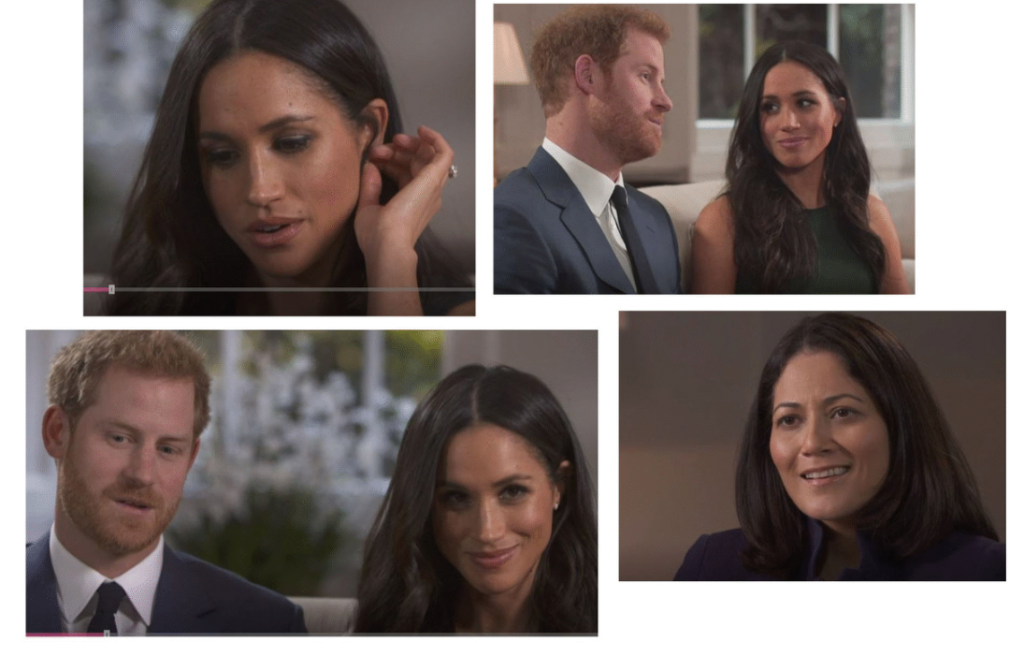
[Ed: The full interview video later released on iPlayer had a single frontal camera (2s) and cutaways to Mishal Hussein. No side camera shots!]
Alasdair Lawrance
I’ve just had a look on the interweb and they seem to have just a 2sh of the happy couple and a single of Ms Hussein.
I do like the shadow of the lit table lamp, tho’.
John Howell
The sound wasn’t free of criticism either, Ms. Hussein’s mic sounded as if it was under 3 layers of carpet felt. Normally I would suggest grabbing a handful of eq but there were no high frequencies to boost. The occasional rustle and click from the Happy Couple’s mics can surely be forgiven, a sound problem is often less severe if the reason for it can be seen in picture.
Dave Plowman
You’d think by now even the most cloth-eared would know the effect of covering a mic with layers of ordinary clothing. Sort of goes back to the old days – the important thing is not to see a mic. How it sounds, very secondary. (I didn’t see the interview).
Geoff Fletcher
Did anyone watch it on Sky News? They did a half hour special at 21:30. If it was the same footage used with a different voice over for the interviewer (she wasn’t shown in shot) I didn’t notice any colour discrepancies, but then I wasn’t giving it my full attention. The sound was not good – the questions were clear, but the replies were as described above.
I also caught a bit of the BBC News At Ten version – the replies from H & M sounded identical and it looked like the same footage, but I did notice the colour change as described. All very odd. Maybe I was more awake for the BBC News! Or maybe someone at Sky gave their version a tweak?
Mike Jordan
I didn’t see either of the bits referred to.
However there were a couple of snippets on Breakfast TV (twice) which, although there were no visual cutaways, his every rapid hand movement looked very jerky as if it been filmed (sic) on mobile phones and upconverted and colourised from 30line TV.
So much for the much vaunted 4k system!
Roger Bunce
I didn’t see it, so I can’t really comment. But these things won’t change until the public complain. So, write to Tony Hall; write to Head of News; write to your MP; write to the “Radio Times”, etc. (possibly not the “Daily Mail”) “…As a Licence Fee Payer…” – “… How dare the BBC insult the Royal Family!…” – “…Was making them look different colours intended to be Racist!…” – etc.
Sometimes things get done. Sometime they don’t, but it makes you feel better.
Have a Rant!


